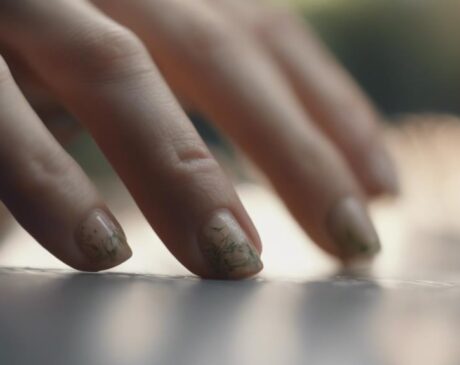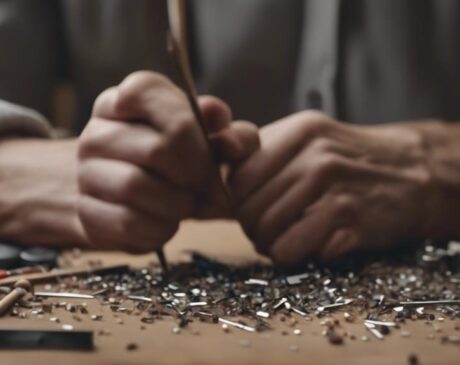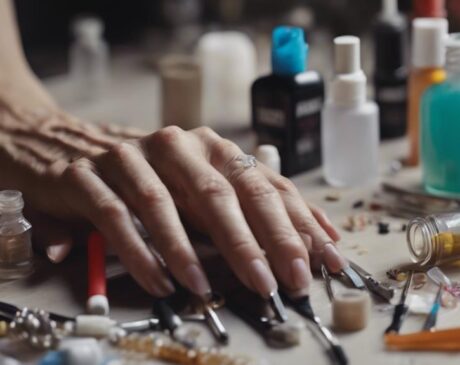How Do Nail Techs Remove Fake Nails?
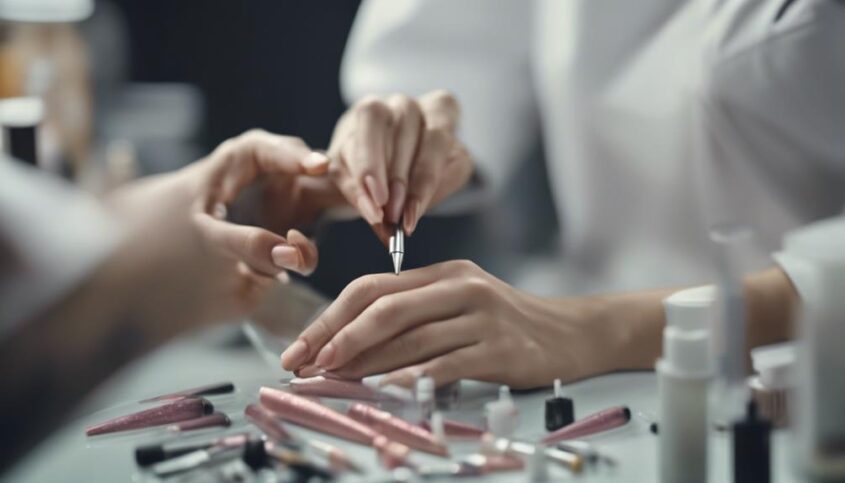
Nail techs use acetone soaking, gentle buffing, nail drills, and professional clippers to remove fake nails effectively. These methods ensure safe and efficient removal without damaging the natural nails. Various tools and techniques are employed for precision and speed, catering to individual preferences and needs. Discover the diverse approaches that can enhance the removal process and prioritize nail health.
Key Takeaways
- Soaking in acetone dissolves fake nails effectively by breaking the adhesive bond for clean removal.
- Gentle buffing smooths natural nails and removes residual material safely for subsequent treatments.
- Nail drills offer precision control and speed settings for quick and professional fake nail removal.
- Utilize professional nail clippers based on nail shape for safe and effective removal prioritizing nail health.
- Wrapping nails in foil with cotton pads accelerates acetone's softening effect, ensuring efficient fake nail removal.
Soaking in Acetone Solution
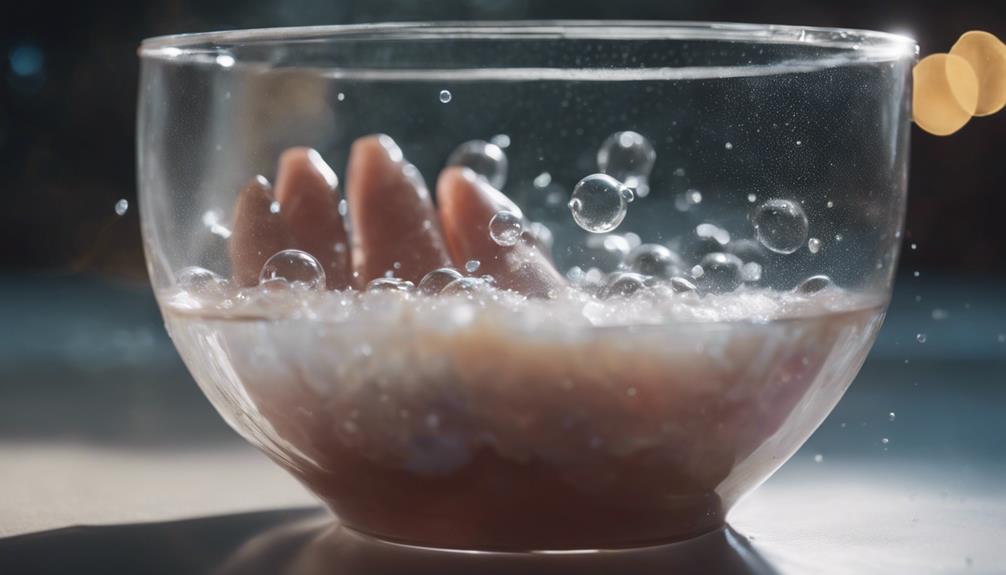
Nail technicians commonly employ a soaking technique utilizing an acetone solution to effectively remove fake nails. Acetone, a powerful solvent, penetrates the layers of the fake nail, breaking down the adhesive bond that attaches it to the natural nail bed. This method is favored for its efficiency and effectiveness in dissolving the acrylic or gel material without causing damage to the natural nails underneath.
When implementing the acetone soaking process, technicians typically begin by gently filing the shiny topcoat of the fake nails to allow the acetone to penetrate more effectively. Next, they soak cotton balls in acetone, placing them directly on the nails and wrapping each finger in aluminum foil to prevent evaporation and enhance the soaking process. After a designated period, usually around 10-15 minutes, the nail technician carefully removes the foil and cotton balls, gently wiping away the softened fake nail material with a cuticle pusher or gentle scraping tool.
This acetone soaking technique is a staple in the nail industry for its ability to efficiently and safely remove fake nails, providing a clean canvas for new nail enhancements or simply allowing the natural nails to breathe and rejuvenate.
Gentle Buffing Technique
Utilizing a gentle buffing technique, nail technicians employ a meticulous approach to safely remove residual fake nail material and smooth the natural nail surface. This innovative method involves using a soft buffing block or file to gently buff away any remaining acrylic or gel material on the nail without causing damage. The goal is to gradually reduce the thickness of the artificial nail layer, revealing the natural nail underneath. By carefully maneuvering the buffing tool across the nail surface, technicians can effectively eliminate any leftover product while ensuring the integrity of the natural nail is maintained.
This gentle buffing technique is particularly beneficial for clients who prefer a non-invasive approach to fake nail removal. It allows for a more controlled and precise method of elimination, reducing the risk of potential damage or discomfort. Additionally, by smoothing the natural nail surface post-removal, this technique helps prepare the nails for any subsequent treatments or applications, ensuring a clean canvas for future nail enhancements.
Nail Drill for Quick Removal
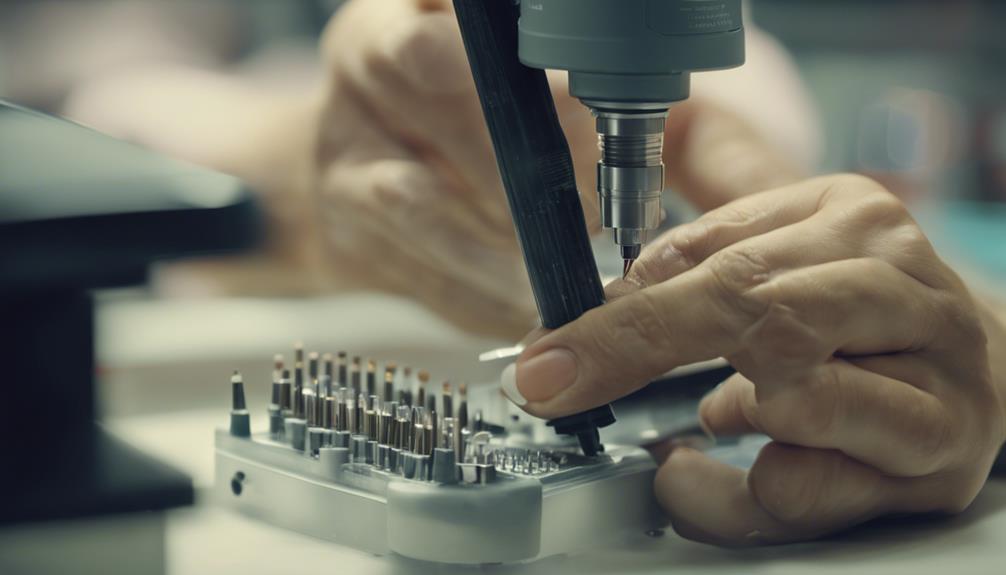
When aiming for expedited removal of fake nails, nail technicians frequently rely on the efficiency of a nail drill. This tool enables technicians to swiftly and effectively remove artificial nails, allowing for a seamless transition to a new nail design or a natural look. Here are four reasons why nail drills are favored for quick removal in the nail care industry:
- Precision Control: Nail drills offer precise control, allowing technicians to target specific areas for removal without causing damage to the natural nail.
- Time Efficiency: With varying speed settings, nail drills can quickly eliminate acrylic or gel nails, saving time for both the technician and the client.
- Versatility: Nail drills come with different attachments that cater to various nail removal techniques, making them versatile tools in the nail technician's arsenal.
- Professional Finish: By using a nail drill for removal, technicians can achieve a professional finish, ensuring that the natural nail remains healthy and undamaged.
Professional Nail Clipper Usage
When it comes to professional nail clipper usage, understanding the different types of nail clippers available is essential. Nail technicians should be well-versed in proper techniques for using nail clippers to ensure a safe and effective nail removal process. Additionally, adhering to safety precautions is highly advised to prevent any accidents or injuries during the nail clipping procedure.
Nail Clipper Types
Professional nail technicians often rely on a variety of specialized nail clipper types to ensure precise and efficient removal of fake nails. These innovative tools are designed to enhance the nail removal process and provide a seamless experience for both the technician and the client. Here are four essential nail clipper types used by professional nail techs:
- Curved Blade Clippers: These clippers have a curved blade that follows the natural shape of the nail, allowing for precise cutting without causing damage.
- Straight Blade Clippers: Ideal for straight-edge fake nails, these clippers provide clean and sharp cuts for a smooth removal process.
- Angled Blade Clippers: With angled blades, these clippers offer versatility in tackling different nail shapes and angles effectively.
- Electric Nail Clippers: These automated clippers provide speed and precision, making them a popular choice for busy nail salons seeking efficiency.
Proper Technique Tips
To ensure a seamless nail removal process, mastering the proper technique for using professional nail clippers is paramount for nail technicians. When using professional nail clippers, it is essential to select the right size and type based on the client's nail shape and desired outcome. Begin by gently trimming the fake nail close to the natural nail bed, ensuring not to cut the natural nail. Utilize the clipper's sharp blade to make precise cuts, avoiding any unnecessary pressure on the natural nail. By following this technique, nail technicians can efficiently remove fake nails without causing damage or discomfort to the client, providing a professional and quality service that prioritizes nail health and aesthetics.
Safety Precautions Advised
In the realm of nail care services, employing safety precautions during the usage of professional nail clippers is indispensable to uphold the highest standards of client well-being and satisfaction. When using professional nail clippers, consider the following safety measures:
- Select Quality Clippers: Opt for durable, sharp clippers to ensure a clean cut without causing damage.
- Proper Sterilization: Sterilize the clippers before and after each use to prevent infections.
- Correct Technique: Use the clippers carefully to avoid injuring the client's nail bed.
- Regular Maintenance: Keep the clippers well-maintained and sharp to ensure efficient and safe use.
Wrapping in Foil and Cotton
To effectively remove fake nails, nail technicians often utilize the foil wrap technique or the cotton pad method. These methods involve wrapping the nails in foil or cotton soaked in acetone to dissolve the adhesive and soften the artificial nails for easy removal. Implementing these techniques with precision and care ensures a successful and efficient removal process.
Foil Wrap Technique
Using a combination of foil and cotton, nail technicians employ the foil wrap technique to effectively remove fake nails. This method is popular for its efficiency and ability to safely dissolve nail enhancements without causing damage to the natural nails. Here are four key steps involved in the foil wrap technique:
- Preparation: Nail techs start by filing the shiny top coat of the fake nail to allow the acetone to penetrate effectively.
- Cotton Application: A small piece of cotton soaked in acetone is placed on top of the nail.
- Wrapping in Foil: Each finger is then wrapped individually in aluminum foil to secure the cotton in place.
- Waiting Period: The nails are left wrapped for about 10-15 minutes to allow the acetone to break down the fake nails before gentle removal.
Cotton Pad Method
Utilizing a combination of foil and cotton pads, the Cotton Pad Method provides an alternative approach for nail technicians to safely and efficiently remove fake nails. This innovative technique involves saturating cotton pads with acetone, wrapping them around the nails, and then securing them in place with foil. The foil helps to trap heat, accelerating the acetone's ability to break down the adhesive holding the fake nails. Nail technicians appreciate this method for its effectiveness in softening the fake nails without causing damage to the natural nails. The Cotton Pad Method not only streamlines the removal process but also ensures a gentle and precise technique, meeting the demands of clients seeking a safe and efficient nail enhancement removal experience.
Electric File Method
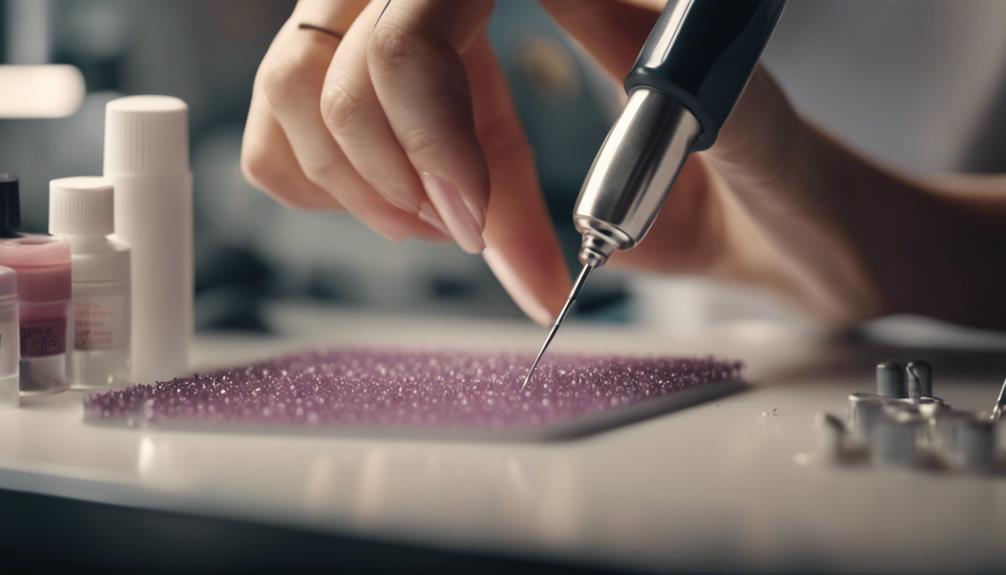
Employing an electric file is a common technique utilized by nail technicians to efficiently remove fake nails. This method offers precision and speed in the removal process, making it a popular choice in nail salons. Here are some key points to consider about the electric file method:
- Efficiency: The electric file allows nail technicians to remove fake nails quickly and effectively, saving both time for the client and the technician.
- Precision: With various file bit options, nail technicians can precisely target the area needing removal without causing damage to the natural nail bed.
- Versatility: Electric files come with different speed settings and attachments, making them versatile tools that can be adjusted based on the type of fake nails being removed.
- Professional Finish: The electric file method often results in a smoother finish compared to traditional methods, providing a professional look that clients appreciate.
Incorporating the electric file method into nail services showcases a commitment to efficiency and innovation in the nail care industry.
Cuticle Softening Process
Implementing a thorough cuticle softening process is essential for preparing the nails before the removal of fake nails in a professional nail care setting. Cuticles act as a protective barrier for the nail matrix, and their softening is crucial to ensure a gentle and effective removal process. Nail technicians often use innovative techniques and products to soften the cuticles, such as cuticle softening creams, oils, or gels. These products are applied around the nail folds and cuticle areas to hydrate and soften the skin, making it easier to push back or remove excess cuticle growth.
One popular method is to soak the nails in warm water or a specialized cuticle softening solution to help loosen the cuticles. Additionally, some technicians may use electric files with gentle attachments to buff the cuticles gently. By softening the cuticles properly, nail techs can minimize discomfort and reduce the risk of damaging the natural nails during the fake nail removal process. This attention to detail ensures a professional and meticulous nail care experience for clients.
Frequently Asked Questions
Can Fake Nails Be Removed Without Using Acetone Solution?
There are alternative methods to remove fake nails without acetone, such as soaking in warm, soapy water or using dental floss. These innovative approaches provide options for individuals seeking a nail removal process that minimizes acetone exposure.
Are There Any Alternatives to Using a Nail Drill for Quick Removal?
In the realm of nail care, professionals are continuously exploring alternative methods to expedite the removal process without relying solely on nail drills. New techniques and tools are being developed to ensure quick and efficient fake nail removal.
How Long Should Fake Nails Be Soaked in Acetone Solution Before Removal?
Nail techs typically recommend soaking fake nails in acetone solution for about 10-15 minutes for optimal removal. This duration allows the solution to effectively break down the adhesive, facilitating a smoother and less damaging removal process for the client's nails.
Is There a Risk of Damaging the Natural Nail With the Electric File Method?
Is there a risk of damaging the natural nail with the electric file method? While the electric file can be efficient, improper use or excessive pressure may harm the natural nail. Skillful technicians prioritize precision and caution to mitigate potential damage.
What Are the Benefits of Using a Professional Nail Clipper for Fake Nail Removal?
Utilizing a professional nail clipper for fake nail removal offers precision and efficiency, reducing the risk of damage to natural nails. This tool ensures a clean and controlled removal process, enhancing the overall experience and results for clients.

